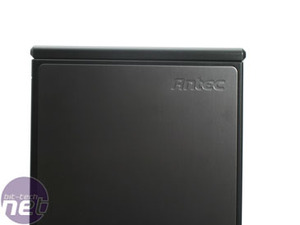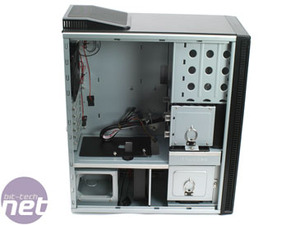
The more we looked at the door, a few more problems became apparent. The magnet hadn't been strengthened in any way as far as we could tell and still felt a little flimsy even though it still held the door well enough.
On reflection, we think this may be more to do with the placement of the magnets than their actual strength. The door is held shut by two small magnets above and below the power button and we couldn't help but feel that a magnet at the top and bottom of the door as a whole would have given a more secure feel to the close.
Then again, the door does have a lock on it for those who want something truly secure, though I can't say I've ever seen the benefit of a lock on a PC door as nobody I know would dare touch my PC anyway.
The other problem we had with the door was just opening the damn thing. True, the magnets are fairly weak but that's no excuse not to have a proper handle for the door. The small recess on the side of the door doesn't feel big enough for our meaty man-fingers and its impossibly difficult to spot the notch if you've set the case up on the right hand side of your desk. It's only a minor niggle obviously, especially since regular users will quickly learn where to pull, but as a flaw it could have been oh-so-easily fixed.
Still, with no further quibbles let's jump inside the case and have a look around.
The PSU is mounted at the bottom of the case and there are a series of trays for drives on the front of the case, each with little handles to use whilst removing them. Each tray is secured in place with rubber grommets that help reduce noise and the handles on each tray can be secured down with clips to further eliminate rattling. It's this level of attention to detail that makes the Antec P1 line so praised among chassis-lovers.
The major difference between the P182 and P180 is that the horrible and inefficient VGA card duct from the P180 is thankfully absent. The back of the case also features some rubber grommeted ports for externally mounted watercooling radiators; again the rubber ensures that the fit is not only tight, but also noiseless.
The case features a total of three fans, with room for another two if the user desires. The standard spinners are all 120mm Tricool fans and there is one mounted in the rear, top and lower chamber of the case, the optional fans in the package would also be 120mm'ers – one for the VGA and another for the front.
Our one major complaint with the original P180 was the amount of clutter caused by routing cables through the various chambers and opening the case shows Antec's solution to this problem. Basically, the company has thrown in a bunch of cable-tidies that can be stuck to the side of the case and the motherboard mount has been moved forward a centimetre so that cables can be routed behind it and kept out of the way.
I guess the only thing we can do is install a system and see how well these cable-tidies do their job.
On reflection, we think this may be more to do with the placement of the magnets than their actual strength. The door is held shut by two small magnets above and below the power button and we couldn't help but feel that a magnet at the top and bottom of the door as a whole would have given a more secure feel to the close.
Then again, the door does have a lock on it for those who want something truly secure, though I can't say I've ever seen the benefit of a lock on a PC door as nobody I know would dare touch my PC anyway.
The other problem we had with the door was just opening the damn thing. True, the magnets are fairly weak but that's no excuse not to have a proper handle for the door. The small recess on the side of the door doesn't feel big enough for our meaty man-fingers and its impossibly difficult to spot the notch if you've set the case up on the right hand side of your desk. It's only a minor niggle obviously, especially since regular users will quickly learn where to pull, but as a flaw it could have been oh-so-easily fixed.
Still, with no further quibbles let's jump inside the case and have a look around.
The Insides
The first thing anyone would notice about the inside of the case is how different it is from 'standard' designs. Just like in the P180 everything has been compartmentalised and sealed off from one another to help keep heat and noise to a minimum. There's so many little cubicles it's like a Dilbert cartoon.The PSU is mounted at the bottom of the case and there are a series of trays for drives on the front of the case, each with little handles to use whilst removing them. Each tray is secured in place with rubber grommets that help reduce noise and the handles on each tray can be secured down with clips to further eliminate rattling. It's this level of attention to detail that makes the Antec P1 line so praised among chassis-lovers.
The major difference between the P182 and P180 is that the horrible and inefficient VGA card duct from the P180 is thankfully absent. The back of the case also features some rubber grommeted ports for externally mounted watercooling radiators; again the rubber ensures that the fit is not only tight, but also noiseless.
The case features a total of three fans, with room for another two if the user desires. The standard spinners are all 120mm Tricool fans and there is one mounted in the rear, top and lower chamber of the case, the optional fans in the package would also be 120mm'ers – one for the VGA and another for the front.
Our one major complaint with the original P180 was the amount of clutter caused by routing cables through the various chambers and opening the case shows Antec's solution to this problem. Basically, the company has thrown in a bunch of cable-tidies that can be stuck to the side of the case and the motherboard mount has been moved forward a centimetre so that cables can be routed behind it and kept out of the way.
I guess the only thing we can do is install a system and see how well these cable-tidies do their job.

MSI MPG Velox 100R Chassis Review
October 14 2021 | 15:04














Want to comment? Please log in.